A Model for Future Development Scenario Planning to Address Population Change and Sea Level Rise
Abstract
1. Introduction
2. Materials and Methods
2.1. Study Area
2.2. Data
2.3. Methods
2.3.1. Scenarios
2.3.2. Assumptions
2.3.3. Suitable Development Areas
2.3.4. Suitability Analysis
2.3.5. Methods for Developing Individual Suitability Layers
2.3.6. Weighting of the Suitability Layers
2.3.7. Development and Population Allocation
2.3.8. Population Allocation Process
3. Results
3.1. Scenario Population Allocations
3.2. Sea Level Rise
3.3. Natural and Agricultural Lands
4. Discussion
4.1. The Need for Scenario-Based Models
4.2. Model Assumptions and Inputs
4.3. Detailed Planning Application
4.4. Sprawl and Conservation Scenario Comparisons
4.5. Other Model Applications
5. Conclusions
Author Contributions
Funding
Data Availability Statement
Acknowledgments
Conflicts of Interest
Abbreviations
| BEBR | Bureau of Economic Business Research |
| CEM | Criteria Evaluation Matrix |
| DORUC | Florida Department of Revenue Land Use Codes |
| DRI | Developments of Regional Impact |
| ESRI | Environmental Systems Research Institute |
| FDACS | Florida Department of Agriculture and Consumer Services |
| FEGN | Florida Ecological Greenways Network |
| FGDL | Florida Geographic Data Library |
| FLMA | Florida Managed Lands |
| FLUCCS | Florida Land Cover Classification System |
| FNAI | Florida Natural Areas Inventory |
| FSAID | Florida Statewide Agricultural Demand |
| FWC | Florida Wildlife Corridor |
| GDD | Gross Development Density |
| GIS | Geographic Information Systems |
| LUCIS | Land Use Conflict Identification Strategy |
| NLCD | National Land Cover Database |
| NOAA | National Oceanic and Atmospheric Administration |
| NRCS | Natural Resources Conservation Service |
| SLR | Sea Level Rise |
| USGS | United States Geological Survey |
Appendix A
Appendix A.1
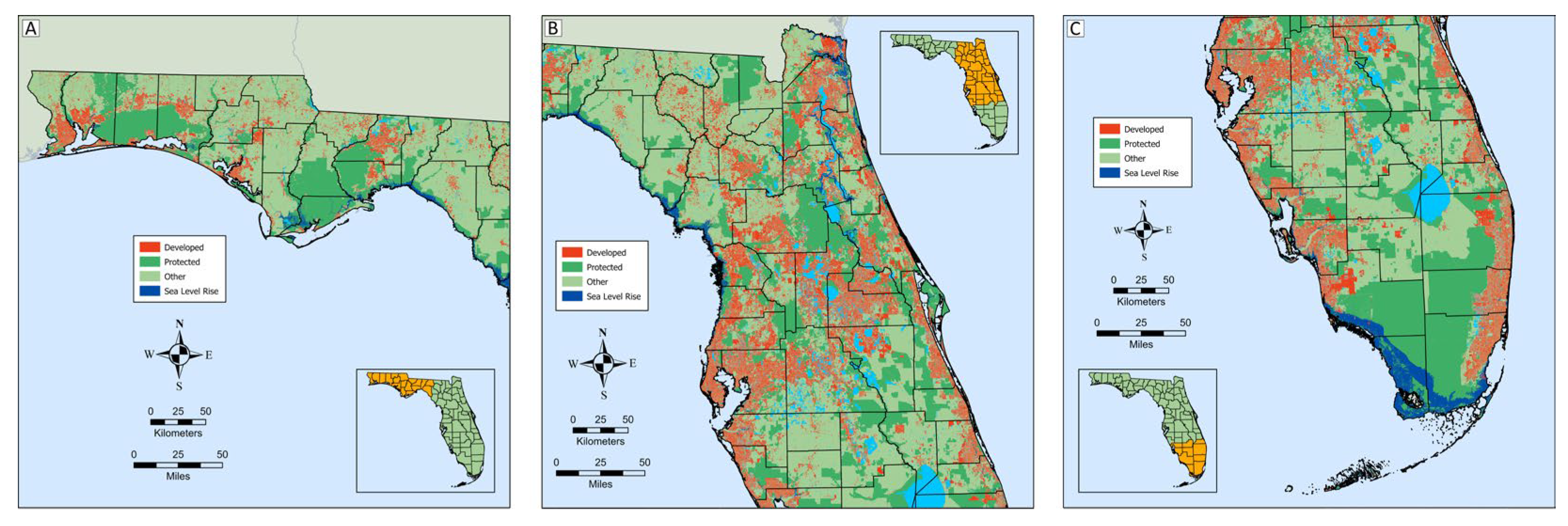
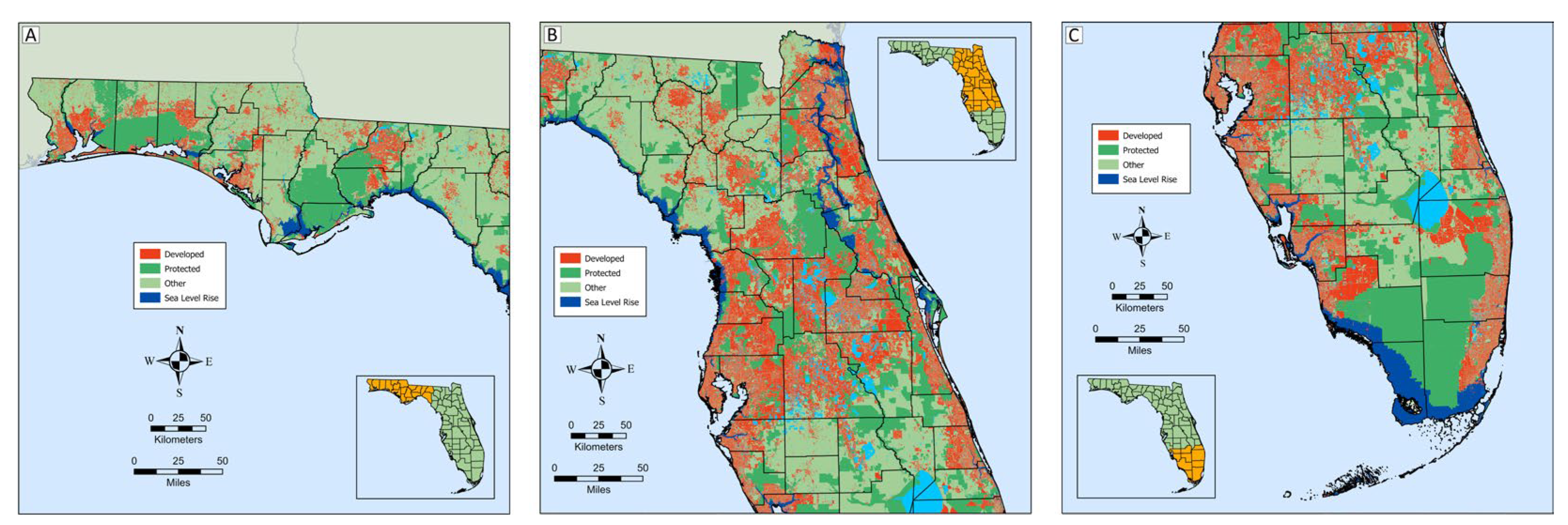
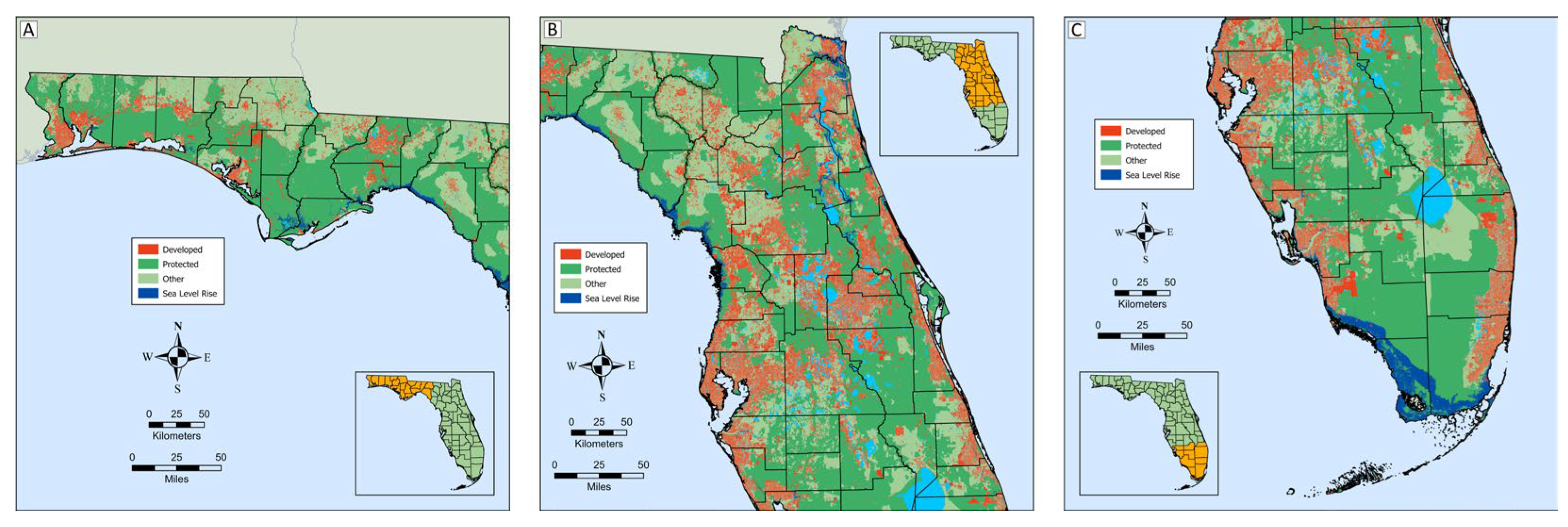

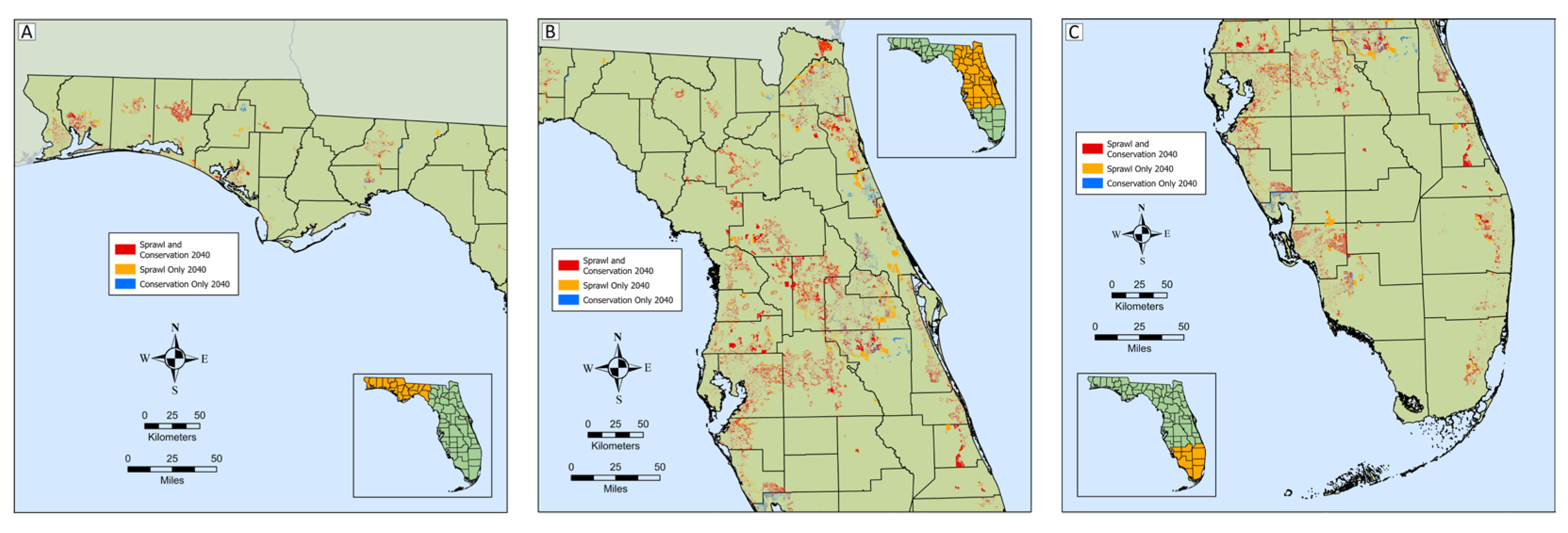
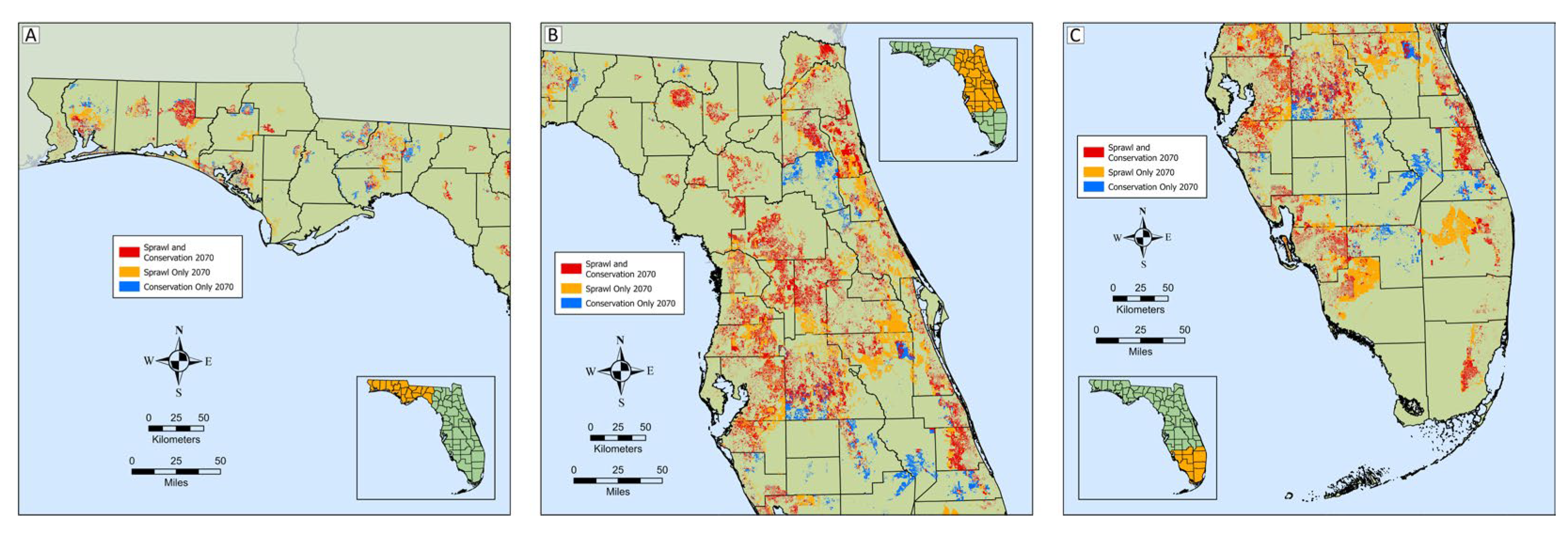
| County | 2040 GDD | 2070 GDD |
|---|---|---|
| ALACHUA | 2.23 | 1.91 |
| BAKER | 1.68 | 1.62 |
| BAY | 1.92 | 1.65 |
| BRADFORD | 1.18 | 1.26 |
| BREVARD | 3.90 | 3.15 |
| BROWARD | 13.44 | 10.85 |
| CALHOUN | 0.96 | 0.95 |
| CHARLOTTE | 2.25 | 1.64 |
| CITRUS | 1.19 | 1.04 |
| CLAY | 2.70 | 2.19 |
| COLLIER | 3.06 | 2.44 |
| COLUMBIA | 0.94 | 0.89 |
| DESOTO | 1.81 | 1.48 |
| DIXIE | 0.67 | 0.60 |
| DUVAL | 5.80 | 4.84 |
| ESCAMBIA | 3.07 | 2.84 |
| FLAGLER | 2.38 | 1.89 |
| FRANKLIN | 0.74 | 0.88 |
| GADSDEN | 1.01 | 1.07 |
| GILCHRIST | 0.57 | 0.53 |
| GLADES | 1.61 | 1.31 |
| GULF | 0.85 | 0.67 |
| HAMILTON | 0.73 | 0.26 |
| HARDEE | 1.68 | 1.79 |
| HENDRY | 1.21 | 1.17 |
| HERNANDO | 2.17 | 1.87 |
| HIGHLANDS | 1.76 | 1.35 |
| HILLSBOROUGH | 6.24 | 4.73 |
| HOLMES | 0.87 | 0.85 |
| INDIAN RIVER | 3.41 | 2.49 |
| JACKSON | 0.75 | 0.74 |
| JEFFERSON | 0.70 | 0.46 |
| LAFAYETTE | 1.00 | 1.04 |
| LAKE | 2.24 | 1.57 |
| LEE | 4.04 | 2.66 |
| LEON | 2.95 | 2.13 |
| LEVY | 0.48 | 0.43 |
| LIBERTY | 0.94 | 1.46 |
| MADISON | 0.73 | 0.79 |
| MANATEE | 4.38 | 3.09 |
| MARION | 1.87 | 1.68 |
| MARTIN | 3.40 | 2.79 |
| MIAMI-DADE | 16.49 | 13.58 |
| MONROE | 5.18 | 3.81 |
| NASSAU | 1.44 | 0.80 |
| OKALOOSA | 3.17 | 2.58 |
| OKEECHOBEE | 1.16 | 1.10 |
| ORANGE | 7.18 | 4.59 |
| OSCEOLA | 4.18 | 2.61 |
| PALM BEACH | 7.45 | 6.23 |
| PASCO | 3.95 | 3.18 |
| PINELLAS | 9.12 | 7.21 |
| POLK | 3.36 | 2.45 |
| PUTNAM | 0.60 | 0.58 |
| ST JOHNS | 3.35 | 1.73 |
| ST LUCIE | 4.69 | 2.82 |
| SANTA ROSA | 2.14 | 1.87 |
| SARASOTA | 3.92 | 4.75 |
| SEMINOLE | 5.15 | 6.47 |
| SUMTER | 2.77 | 2.32 |
| SUWANNEE | 0.52 | 0.48 |
| TAYLOR | 0.69 | 0.74 |
| UNION | 2.18 | 2.75 |
| VOLUSIA | 2.95 | 2.16 |
| WAKULLA | 1.10 | 0.84 |
| WALTON | 1.04 | 0.71 |
| WASHINGTON | 0.57 | 0.53 |
| Period | 2019 Census | Population Projection | Percent Increase | Additional Population to be Allocated |
|---|---|---|---|---|
| 2019–2040 | 21,477,737 | 26,406,000 | 23% | 4,928,263 |
| 2019–2070 | 21,477,737 | 33,721,828 | 57% | 12,244,091 |
| County | Percent of New Population to be Accommodated Through Redevelopment | County | Percent of New Population to be Accommodated Through Redevelopment |
|---|---|---|---|
| ALACHUA | 13 | LEE | 40 |
| BAKER | 10 | LEON | 13 |
| BAY | 10 | LEVY | 10 |
| BRADFORD | 10 | LIBERTY | 10 |
| BREVARD | 25 | MADISON | 10 |
| BROWARD | 60 | MANATEE | 13 |
| CALHOUN | 10 | MARION | 13 |
| CHARLOTTE | 40 | MARTIN | 13 |
| CITRUS | 40 | MIAMI-DADE | 40 |
| CLAY | 13 | MONROE | 60 |
| COLLIER | 13 | NASSAU | 10 |
| COLUMBIA | 10 | OKALOOSA | 13 |
| DESOTO | 10 | OKEECHOBEE | 10 |
| DIXIE | 10 | ORANGE | 40 |
| DUVAL | 40 | OSCEOLA | 10 |
| ESCAMBIA | 13 | PALM BEACH | 13 |
| FLAGLER | 10 | PASCO | 25 |
| FRANKLIN | 10 | PINELLAS | 60 |
| GADSDEN | 10 | POLK | 13 |
| GILCHRIST | 10 | PUTNAM | 13 |
| GLADES | 10 | ST JOHNS | 10 |
| GULF | 10 | ST LUCIE | 10 |
| HAMILTON | 10 | SANTA ROSA | 10 |
| HARDEE | 10 | SARASOTA | 25 |
| HENDRY | 10 | SEMINOLE | 40 |
| HERNANDO | 25 | SUMTER | 10 |
| HIGHLANDS | 13 | SUWANNEE | 10 |
| HILLSBOROUGH | 40 | TAYLOR | 10 |
| HOLMES | 10 | UNION | 10 |
| INDIAN RIVER | 13 | VOLUSIA | 25 |
| JACKSON | 10 | WAKULLA | 10 |
| JEFFERSON | 10 | WALTON | 10 |
| LAFAYETTE | 10 | WASHINGTON | 10 |
| LAKE | 25 |
| DESCRIPTION |
|---|
| AIRPORTS, MARINAS, BUS TERMINALS, AND PIERS |
| AUTOMOTIVE REPAIR, SERVICE, AND SALES |
| BOARDING HOMES (INSTITUTIONAL) |
| BOWLING ALLEYS, SKATING RINGS, ENCLOSED ARENAS |
| CANNERIES, DISTILLERIES, AND WINERIES |
| CHURCHES |
| CLUBS, LODGES, AND UNION HALLS |
| COLLEGES |
| COMMUNITY SHOPPING CENTERS |
| CONDOMINIA |
| COOPERATIVES |
| CULTURAL ORGANIZATIONS |
| DEPARTMENT STORES |
| DRIVE-IN RESTAURANTS |
| DRIVE-IN THEATERS, OPEN STADIUMS |
| ENCLOSED THEATERS, AUDITORIUMS |
| FINANCIAL INSTITUTIONS |
| FLORIST, GREENHOUSES |
| FRUIT, VEGETABLES, AND MEAT PACKING |
| GOLF COURSES |
| HEAVY MANUFACTURING |
| HOMES FOR AGED |
| HOTELS, MOTELS |
| INDUSTRIAL STORAGE (FUEL, EQUIP, AND MATERIAL) |
| INSURANCE COMPANY OFFICES |
| LIGHT MANUFACTURING |
| LUMBER YARDS, SAWMILLS, PLANNING MILLS |
| MIXED USE, I.E., STORE AND OFFICE |
| MOBILE HOMES |
| MORTUARIES, CEMETERIES |
| MULTI-FAMILY |
| MULTI-FAMILY LESS THAN 10 UNITS |
| MULTI-STORY NON-PROFESSIONAL OFFICES |
| NIGHT CLUBS, BARS, AND COCKTAIL LOUNGES |
| ONE-STORY NON-PROFESSIONAL OFFICES |
| OTHER FOOD PROCESSING |
| OTHER MUNICIPAL |
| PARKING LOTS, MOBILE HOME SALES |
| PRIVATE HOSPITALS |
| PRIVATE SCHOOLS |
| PROFESSIONAL SERVICE BUILDINGS |
| PUBLIC HOSPITALS |
| PUBLIC SCHOOLS |
| RACE HORSE, AUTO, AND DOG TRACKS |
| REGIONAL SHOPPING MALLS |
| REPAIR SERVICE SHOPS |
| RESTAURANTS, CAFETERIAS |
| RETIREMENT HOMES |
| SANITARIUMS, CONVALESCENT, AND BEST HOMES |
| SERVICE STATIONS |
| SINGLE FAMILY |
| STORES ONE-STORY |
| SUPERMARKET |
| TOURIST ATTRACTIONS |
| UTILITIES |
| VACANT COMMERCIAL |
| VACANT INDUSTRIAL |
| VACANT INSTITUTIONAL |
| VACANT RESIDENTIAL |
| WAREHOUSES, AND DISTRIBUTION CENTERS |
| WHOLESALE, MANUFACTURING, AND PRODUCE OUTLETS |
| Data Layer | Year | Data Repository | Source Layer Name |
|---|---|---|---|
| 2040 and 2070 conservation lands in Florida | 2022 | FGDL | sl2040_2070_cons_protect_may23 |
| 2040/2070 Baseline | 2022 | FGDL | CLCP Sea Level 2040 and 2070 Project Baseline Scenario: 2019 Developed Lands in Florida–2022 |
| Coastline | 2004 | FGDL | Florida Coastline |
| Counties | 2015 | FGDL | Florida County Boundaries–September 2015 |
| Developments of Regional Impact | 2018 | FGDL | Developments of Regional Impact In The State of Florida–2018 Quarter 1 FGDL |
| Florida Cities | 2004 | FGDL | Cities and Towns Of Florida |
| Florida Ecological Greenways Network | 2021 | FGDL | FEGN_2021 |
| Florida Forever | 2020 | FNAI | Florida Forever Acquisitions–September 2020 |
| Florida Managed Areas | 2020 | FNAI | Florida Managed Areas Data Layer (June 2020) |
| Florida Statewide Agricultural Irrigation Demand (FSAID) | 2018 | FDACS | Fsaid_2018_Ilg_Final |
| Indian Reservations | 2017 | FGDL | American Indian Lands and Native Entities in Florida–2017 |
| Major Roads | 2019 | FGDL | Florida Department of Transportation–RCI Derived Major Roads–October 2019 |
| Mitigation Banks | 2019 | FGDL | Mitigation Banks In Florida–May 2019 |
| Parcels | 2019 | FGDL | Florida Parcel Data Statewide–2019 |
| Private Conservation Easements (FDEP) | 2021 | SFWMD | Conservation_Easements_No_Partial_Release |
| Private Conservation Easements (FDEP) | 2018 | FDEP | Conservation_Easements_Areas |
| Private Conservation Easements (SJRWMD) | 2020 | SJRWMD | Open Data Permit Regulatory |
| Private Conservation Easements (UFCLCP) | 2021 | NRCS | Nrcs Easements_062021_Permanent Only |
| Reedy Creek Development District | 2011 | FGDL | East Central Florida Regional Planning Council Generalized Future Landuse–2011 |
| Sea Level 2040 Conservation Scenario. | 2022 | FGDL | sl2040_conservation_may23 |
| Sea Level 2040 Sprawl Scenario | 2022 | FGDL | sl2040_sprawl_may23 |
| Sea Level 2070 Conservation Scenario | 2022 | FGDL | sl2070_conservation_may23 |
| Sea Level 2070 Sprawl Scenario | 2022 | FGDL | sl2070_sprawl_may23 |
| Urban Areas | 2010 | FGDL | 2010 U.S. Census Urban Areas And Clusters In Florida |
References
- Randolph, J. Environmental Land Use Planning and Management, 2nd ed.; Island Press: Washington, DC, USA, 2012; ISBN 978-1-59726-730-4. [Google Scholar]
- Geneletti, D. Assessing the Impact of Alternative Land-Use Zoning Policies on Future Ecosystem Services. Environ. Impact Assess. Rev. 2013, 40, 25–35. [Google Scholar] [CrossRef]
- Beardsley, K.; Thorne, J.H.; Roth, N.E.; Gao, S.; McCoy, M.C. Assessing the Influence of Rapid Urban Growth and Regional Policies on Biological Resources. Landsc. Urban Plan. 2009, 93, 172–183. [Google Scholar] [CrossRef]
- Kok, K.; van Vliet, M.; Bärlund, I.; Dubel, A.; Sendzimir, J. Combining Participative Backcasting and Exploratory Scenario Development: Experiences from the SCENES Project. Backcasting Sustain. 2011, 78, 835–851. [Google Scholar] [CrossRef]
- Li, L.; Huang, X.; Yang, H. Scenario-Based Urban Growth Simulation by Incorporating Ecological-Agricultural-Urban Suitability into a Future Land Use Simulation Model. Cities 2023, 137, 104334. [Google Scholar] [CrossRef]
- Yanhua, X.; Tyler, L. Description of the Approach, Data and Analytical Methods Used for the Farms Under Threat 2040 Projections of Future Agricultural Land Conversion; University of Wisconsin-Madison: Madison, WI, USA, 2022; p. 21. [Google Scholar]
- Foley, J.A.; DeFries, R.; Asner, G.P.; Barford, C.; Bonan, G.; Carpenter, S.R.; Chapin, F.S.; Coe, M.T.; Daily, G.C.; Gibbs, H.K.; et al. Global Consequences of Land Use. Science 2005, 309, 570–574. [Google Scholar] [CrossRef]
- Demographic Estimating Conference Florida Demographic Forecast. Available online: https://edr.state.fl.us/Content/conferences/population/ (accessed on 12 May 2025).
- Carr, M.H.; Zwick, P.D. Florida 2060 Version 2.0: Three Alternative Land Use Scenarios: A Trend Scenario and Two Scenarios That Consider Sea Level Rise; University of Florida Center for Landscape Conservation Planning: Gainesville, FL, USA, 2013; p. 21. [Google Scholar]
- Carr, M.H.; Zwick, P.D. Florida 2070 Mapping Florida’s Future—Alternative Patterns of Development in 2070; Geoplan Center at the University of Florida: Gainesville, FL, USA, 2016; p. 35. [Google Scholar]
- Zwick, P.D.; Patten, I.E.; Arafat, A. Advanced Land-Use Analysis for Regional Geodesign: Using LUCISplus, 1st ed.; Esri Press: Redlands, CA, USA, 2016; ISBN 978-1-58948-389-7. [Google Scholar]
- Pickard, B.; Gray, J.; Meentemeyer, R. Comparing Quantity, Allocation and Configuration Accuracy of Multiple Land Change Models. Land 2017, 6, 52. [Google Scholar] [CrossRef]
- Vargas, J.C.; Flaxman, B.; Fradkin, B. Landscape Conservation and Climate Change Scenarios for the State of Florida: A Decision Support System for Strategic Conservation; GeoAdaptive LLC: Boston, MA, USA, 2014. [Google Scholar]
- Van Berkel, D.; Shashidharan, A.; Mordecai, R.S.; Vatsavai, R.; Petrasova, A.; Petras, V.; Mitasova, H.; Vogler, J.B.; Meentemeyer, R.K. Projecting Urbanization and Landscape Change at Large Scale Using the FUTURES Model. Land 2019, 8, 144. [Google Scholar] [CrossRef]
- Florida Fish and Wildlife Conservation Commission. State Wildlife Action Plan; Florida Fish and Wildlife Conservation Commission: Tallahassee, FL, USA, 2019; p. 253. [Google Scholar]
- Chassignet, E.P.; Jones, J.W.; Misra, V.; Obeysekera, J.T.B. Florida Climate Institute. Sponsoring Body. In Florida’s Climate: Changes, Variations, & Impacts; Florida Climate Institute: Gainesville, FL, USA, 2017; ISBN 978-1-9790-9104-6. [Google Scholar]
- Noss, R.F.; Platt, W.J.; Sorrie, B.A.; Weakley, A.S.; Means, D.B.; Costanza, J.; Peet, R.K. How Global Biodiversity Hotspots May Go Unrecognized: Lessons from the North American Coastal Plain. Divers. Distrib. 2015, 21, 236–244. [Google Scholar] [CrossRef]
- Whitney, E.N.; Means, D.B.; Rudloe, A. Priceless Florida: Natural Ecosystems and Native Species, 1st ed.; Pineapple Press: Sarasota, FL, USA, 2004. [Google Scholar]
- Agriculture 2040–2070; 1000 Friends of Florida: Tallahassee, FL, USA. 2024, p. 38. Available online: https://1000fof.org/wp-content/uploads/2024/01/FOF-1306-Ag-2040-2070-Report-v4-WEB.pdf (accessed on 5 May 2025).
- 2025 Florida’s Agriculture and Food System Fast Facts; University of Florida: Gainesville, FL, USA. 2025. Available online: https://fred.ifas.ufl.edu/extension/economic-impact-analysis-program/florida-ag-food-and-resources. (accessed on 5 May 2025).
- Decker, J.D.; Hughes, J.D.; Swain, E.D. Geological Survey (U.S.). Issuing Body. In Potential for Increased Inundation in Flood-Prone Regions of Southeast Florida in Response to Climate and Sea-Level Changes in Broward County, Florida, 2060–2069; Scientific investigations report, 2018-5125; Scientific investigations report, 2018-5125; U.S. Department of the Interior, U.S. Geological Survey: Reston, VA, USA, 2019. [Google Scholar]
- Sunshine State Home to Metro Areas Among Top 10 U.S. Population Gainers From 2022 to 2023. United States Census Bureau Washinton, D.C., USA. 2024. Available online: https://www.census.gov/newsroom/press-releases/2024/population-estimates-more-counties-population-gains-2023.html (accessed on 1 May 2025).
- Romañach, S.S.; Benscoter, A.M.; Haider, S.M. Potential Impacts of Future Urbanization and Sea Level Rise on Florida’s Natural Resources. J. Fish Wildl. Manag. 2020, 11, 174–184. [Google Scholar] [CrossRef]
- Carr, M.H.; Zwick, P.D. Smart Land-Use Analysis: The LUCIS Model Land-Use Conflict Identification Strategy, 1st ed.; ESRI Press: Redlands, CA, USA, 2007; ISBN 978-1-58948-174-9. [Google Scholar]
- Florida Natural Areas Inventory. Available online: https://www.fnai.org/publications/gis-data (accessed on 13 May 2025).
- Florida Forever | Florida Department of Environmental Protection. Available online: https://floridadep.gov/lands/environmental-services/content/florida-forever (accessed on 13 May 2025).
- FEGN—Center for Landscape Conservation Planning. Available online: https://conservation.dcp.ufl.edu/fegn/ (accessed on 16 July 2025).
- Hoctor, T.S.; Bohnett, E.; O’Brien, M.; Thompson, E.; Noss, R.; Lockhart, S.; Volk, M.; Carr, P.; Smith, D.J.; Guthrie, J.M.; et al. Refining the Florida Ecological Greenways Network for Improved Landscape Planning and Conservation Prioritization. Landsc. Ecol. 2025, 40, 36. [Google Scholar] [CrossRef]
- Rayer, S.; Wang, Y. Florida Population Studies Volume 55, Bulletin 192 February 2022; University of Florida: Gainesville, FL, USA, 2022; Volume 55, p. 9. [Google Scholar]
- Sweet, W.V.; Hamlington, B.D.; Kopp, R.E.; Weaver, C.P.; Barnard, P.L.; Bekaert, D.; Brooks, W.; Craghan, M.; Dusek, G.; Frederikse, T.; et al. Global and Regional Sea Level Rise Scenarios for the United States: Updated Mean Projections and Extreme Weather Level Probabilities along US Coastlines; National Oceanic and Atmospheric Administration: Silver Spring, MD, USA, 2022. [Google Scholar]
- Sweet, W.V.; Kopp, R.; Weaver, C.P.; Obeysekera, J.; Horton, R.M.; Thieler, E.R.; Zervas, C.E. Global and Regional Sea Level Rise Scenarios for the United States; National Oceanic and Atmospheric Administration: Silver Spring, MD, USA, 2017. [Google Scholar] [CrossRef]
- Hauer, M.E. Migration Induced by Sea-Level Rise Could Reshape the US Population Landscape. Nat. Clim. Change 2017, 7, 321–325. [Google Scholar] [CrossRef]
- Highfield, W.E.; Brody, S.D. Price of Permits: Measuring the Economic Impacts of Wetland Development on Flood Damages in Florida. Nat. Hazards Rev. 2006, 7, 123–130. [Google Scholar] [CrossRef]
- Hawbaker, T.J.; Radeloff, V.C.; Hammer, R.B.; Clayton, M.K. Road Density and Landscape Pattern in Relation to Housing Density, and Ownership, Land Cover, and Soils. Landsc. Ecol. 2005, 20, 609–625. [Google Scholar] [CrossRef]
- Malczewski, J. GIS-Based Land-Use Suitability Analysis: A Critical Overview. Prog. Plan. 2004, 62, 3–65. [Google Scholar] [CrossRef]
- United States Census Bureau. TIGER/Line Shapefiles and TIGER/Line Files Technical Documentation. Available online: https://www.census.gov/programs-surveys/geography/technical-documentation/complete-technical-documentation/tiger-geo-line.html (accessed on 15 May 2025).
- Kneebone, E.; Holmes, N. The Growing Distance between People and Jobs in Metropolitan America. Brook Inst March. 2015. Available online: https://www.brookings.edu/wp-content/uploads/2016/07/srvy_jobsproximity.pdf (accessed on 1 October 2020).
- Van Rooy, J. The Development of Regional Impact in Florida’s Growth Management Scheme: The Changing Role in Regionalism. Fla. State Univ. J. Land Use Environ. Law. 2018, 19, 2. [Google Scholar]
- General Information About Developments of Regional Impact and Florida Quality Developments–Florida Department of Commerce. Available online: https://floridajobs.org/community-planning-and-development/programs/community-planning-table-of-contents/general-information (accessed on 13 May 2025).
- Developments of Regional Impact. Available online: https://sfregionalcouncil.org/dri/ (accessed on 13 May 2025).
- Cho, S.-H.; Kim, S.G.; Roberts, R.K. Values of Environmental Landscape Amenities during the 2000–2006 Real Estate Boom and Subsequent 2008 Recession. J. Environ. Plan. Manag. 2011, 54, 71–91. [Google Scholar] [CrossRef]
- Seidel, V.; Yacobellis, P.; Fountain, J. Florida Statewide Agricultural Irrigation Demand Appendix E – Technical Information; The Balmoral Group: Winter Park, FL, USA, 2025. [Google Scholar]
- Pilkey, O.H.; Pilkey, K.C. Sea Level Rise: A Slow Tsunami on America’s Shores; Duke University Press: Durham, UK, 2019; ISBN 978-1-4780-0512-4. [Google Scholar]
- National Research Council (U.S.); Committee on Sea Level Rise in California Oregon and Washington; National Research Council (U.S.); Board on Earth Sciences and Resources; National Research Council (U.S.); Ocean Studies Board; National Research Council (U.S.); Division on Earth and Life Studies. Sea-Level Rise for the Coasts of California, Oregon, and Washington Past, Present, and Future; National Academies Press: Washington, DC, USA, 2012; ISBN 978-0-309-25595-0.
- Lai, Z.; Chen, C.; Chen, J.; Wu, Z.; Wang, F.; Li, S. Multi-Scenario Simulation of Land-Use Change and Delineation of Urban Growth Boundaries in County Area: A Case Study of Xinxing County, Guangdong Province. Land 2022, 11, 1598. [Google Scholar] [CrossRef]
- Liu, X.; Liang, X.; Li, X.; Xu, X.; Ou, J.; Chen, Y.; Li, S.; Wang, S.; Pei, F. A Future Land Use Simulation Model (FLUS) for Simulating Multiple Land Use Scenarios by Coupling Human and Natural Effects. Landsc. Urban Plan. 2017, 168, 94–116. [Google Scholar] [CrossRef]
- Han, H.; Yang, C.; Song, J. Scenario Simulation and the Prediction of Land Use and Land Cover Change in Beijing, China. Sustainability 2015, 7, 4260–4279. [Google Scholar] [CrossRef]
- Veldkamp, A.; Lambin, E.F. Predicting Land-Use Change. Agric. Ecosyst. Environ. 2001, 85, 1–6. [Google Scholar] [CrossRef]
- Verburg, P.H.; Schot, P.P.; Dijst, M.J.; Veldkamp, A. Land Use Change Modelling: Current Practice and Research Priorities. Geo J. 2004, 61, 309–324. [Google Scholar] [CrossRef]
- Ventura, S.J. The Use of Geographic Information Systems in Local Government. Public Adm. Rev. 1995, 55, 461–467. [Google Scholar] [CrossRef]
- Holdstock, D.A. Strategic GIS Planning and Management in Local Government, 1st ed.; CRC Press: Boca Raton, FL, USA, 2016; ISBN 978-1-4665-5651-5. [Google Scholar]
- Kyzar, T.; Volk, M.; Farrah, D.; Owens, P.; Hoctor, T. Future Development and Water Quality for the Pensacola and Perdido Bay Estuary Program: Applications for Urban Development Planning. Land 2025, 14, 1446. [Google Scholar] [CrossRef]
- Farrah, D.; Volk, M.; Center for Landscape Conservation Planning and 1000 Friends of Florida. Martin County 2040 Western Lands Study. Final Report; Center for Landscape Conservation Planning and 1000 Friends of Florida: Tallahassee, FL, USA, 2024. [Google Scholar]
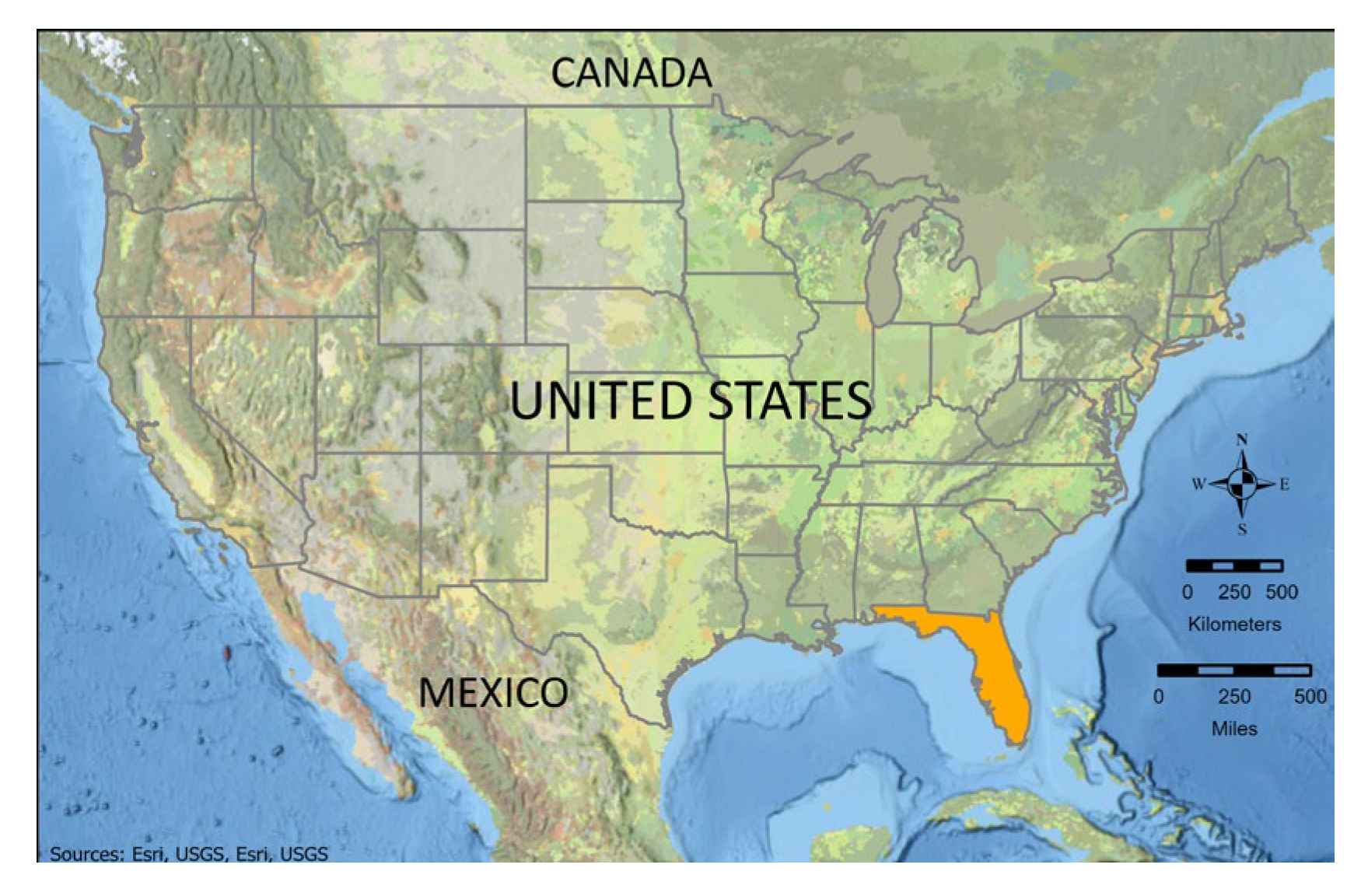
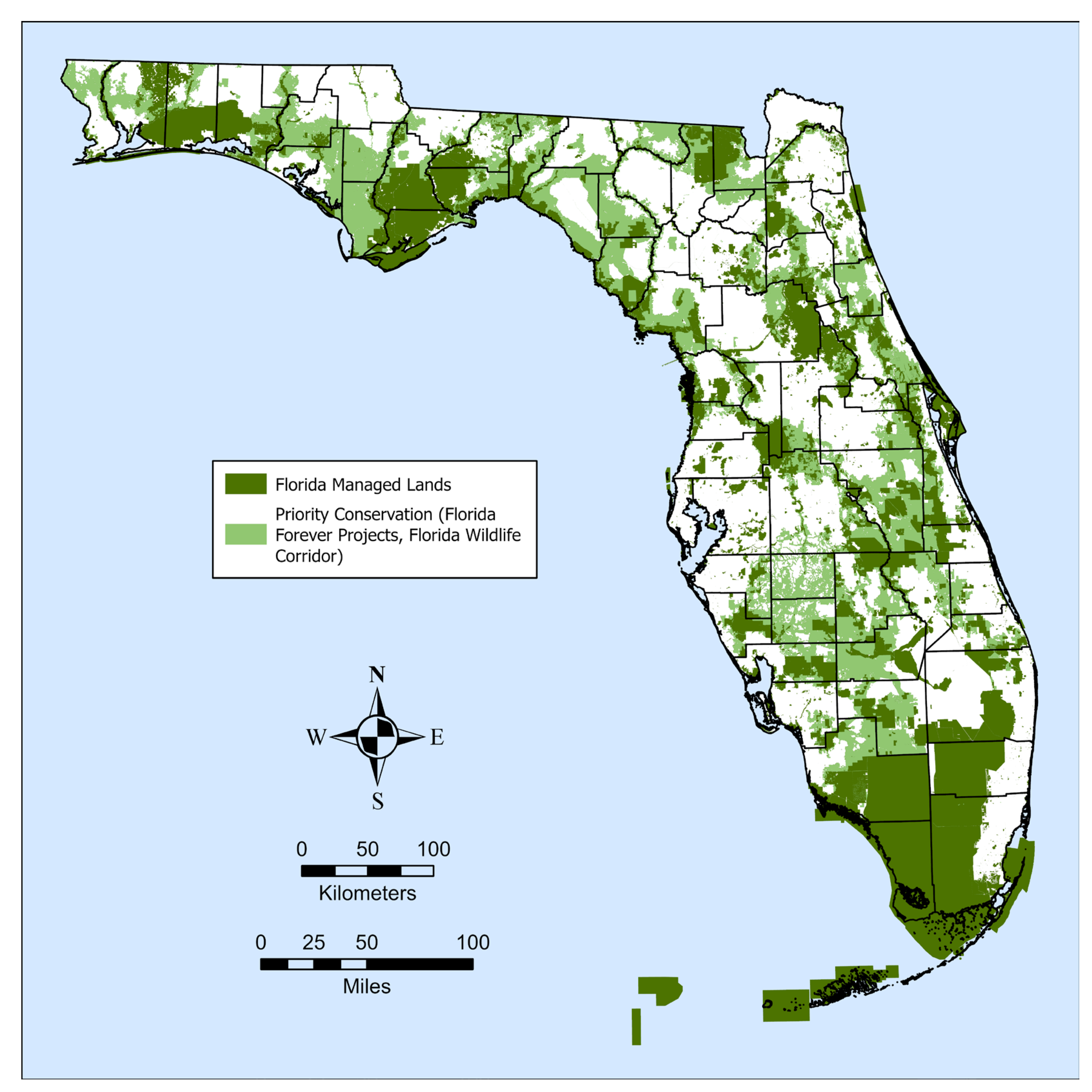
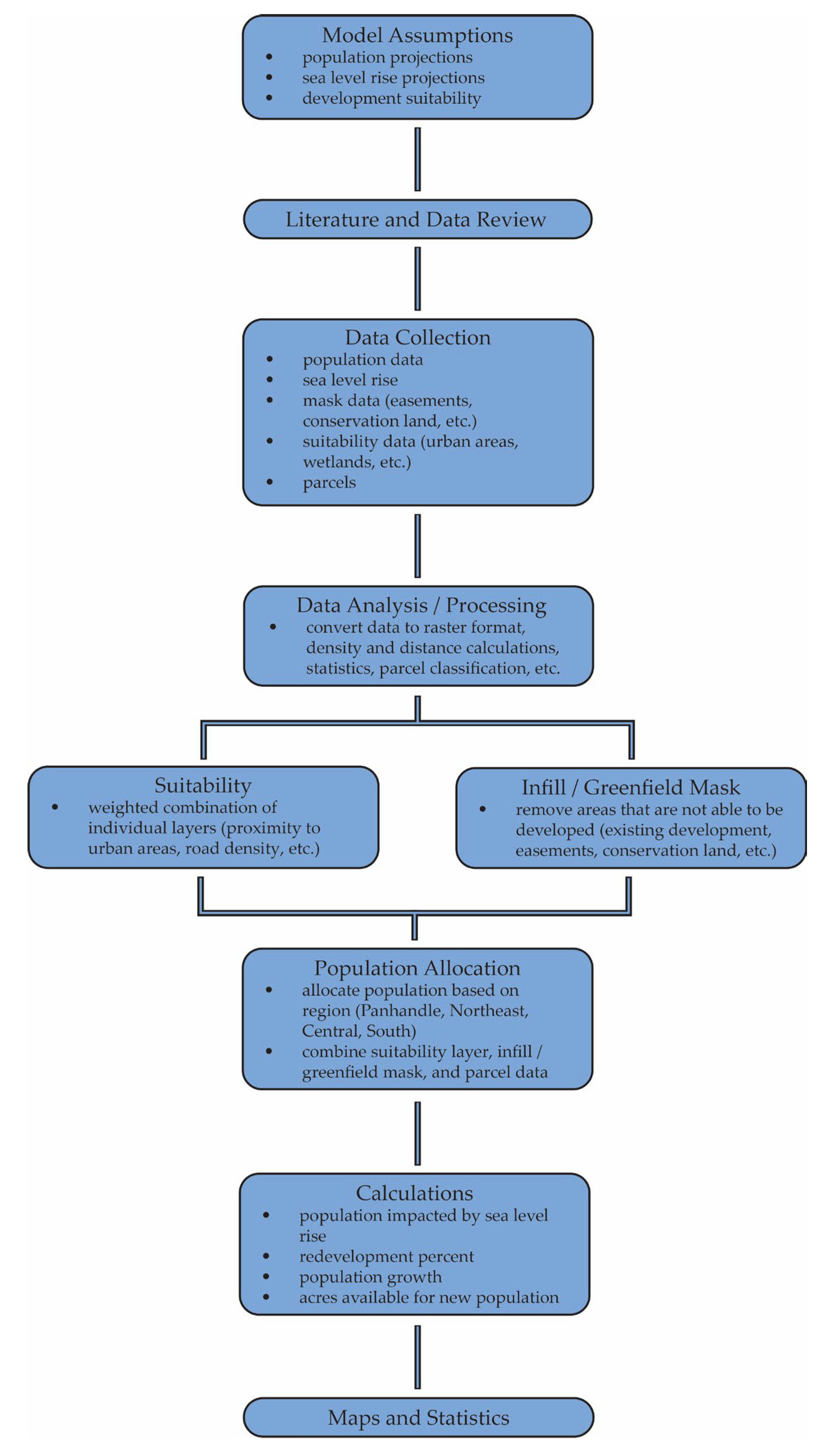
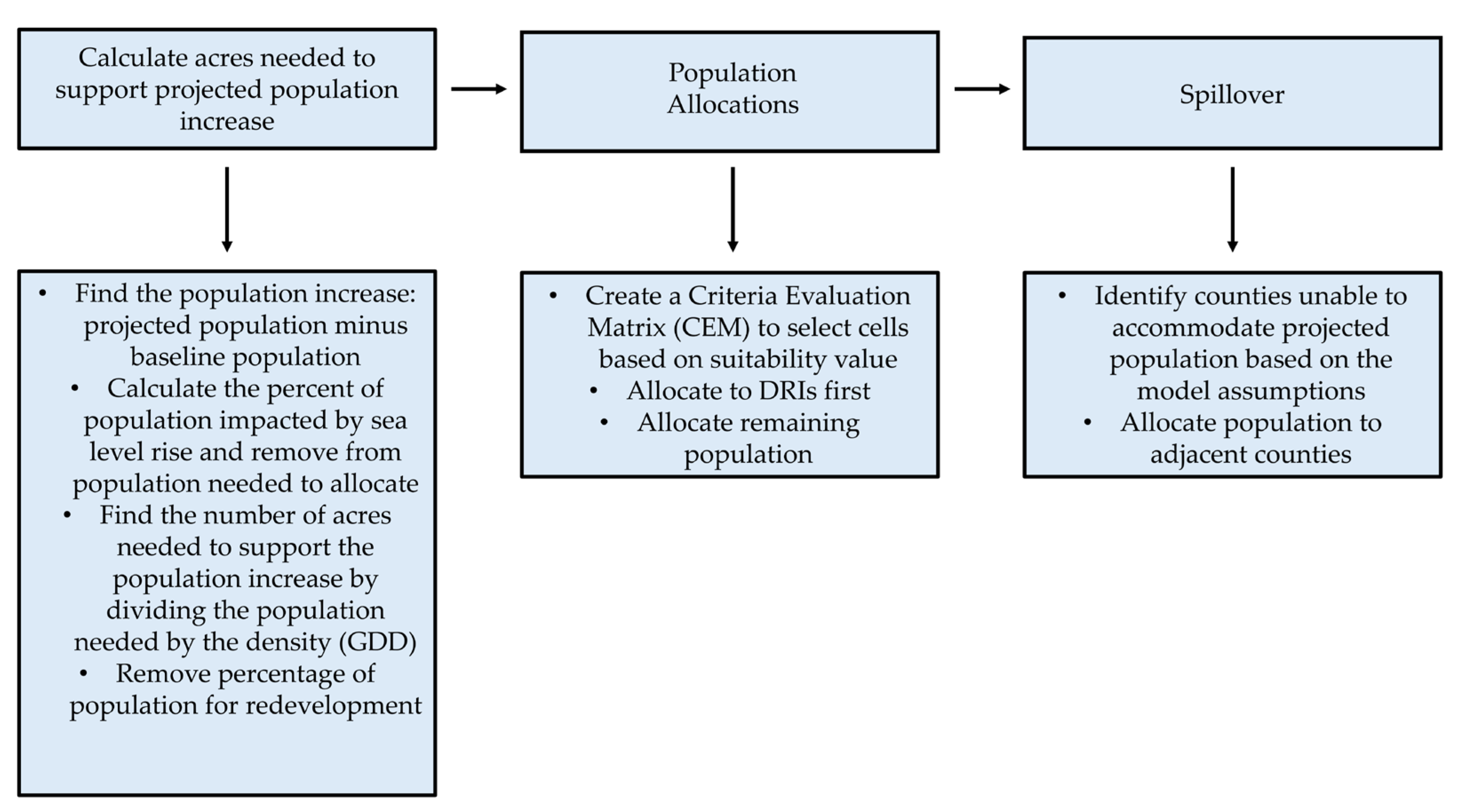
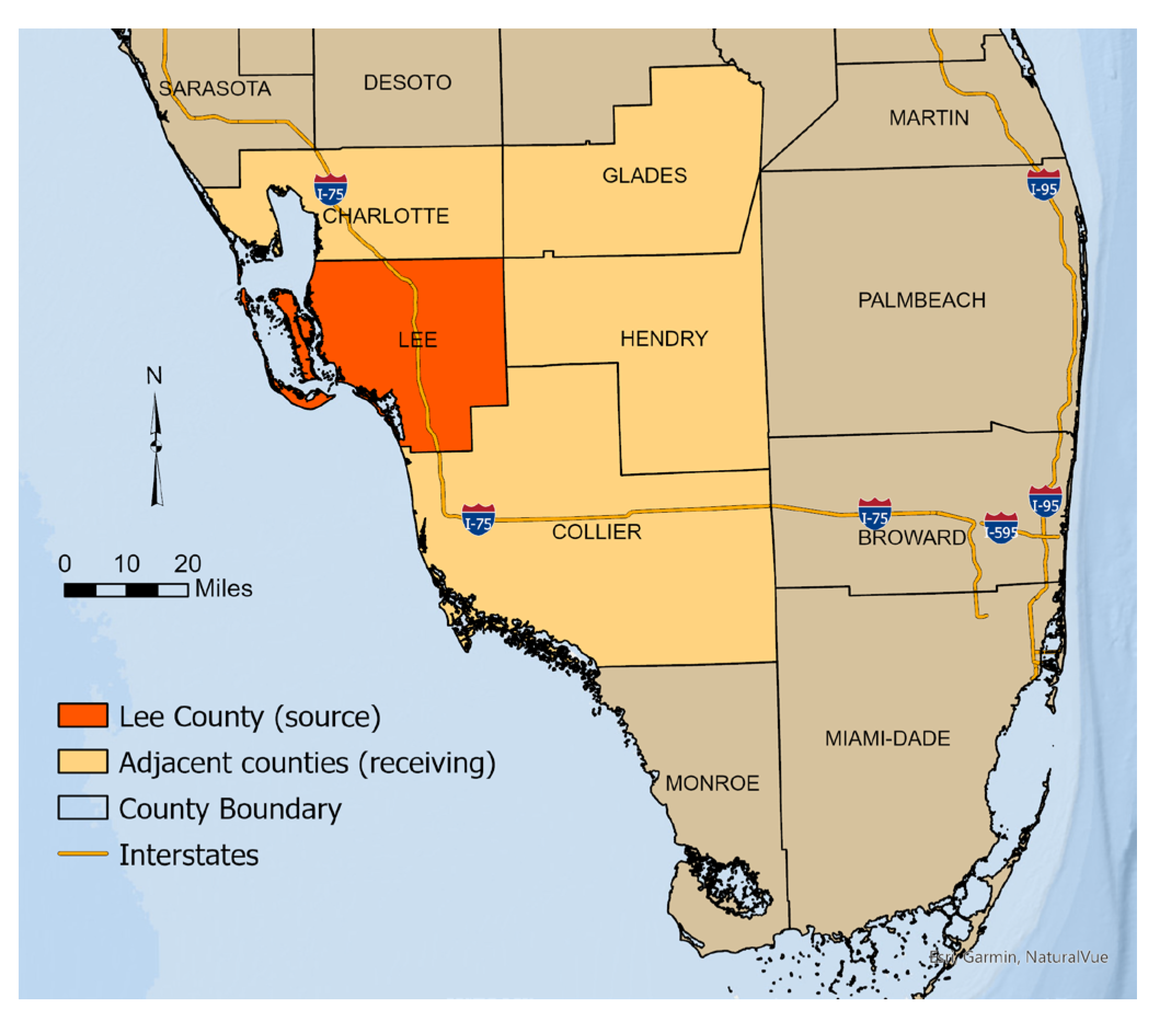
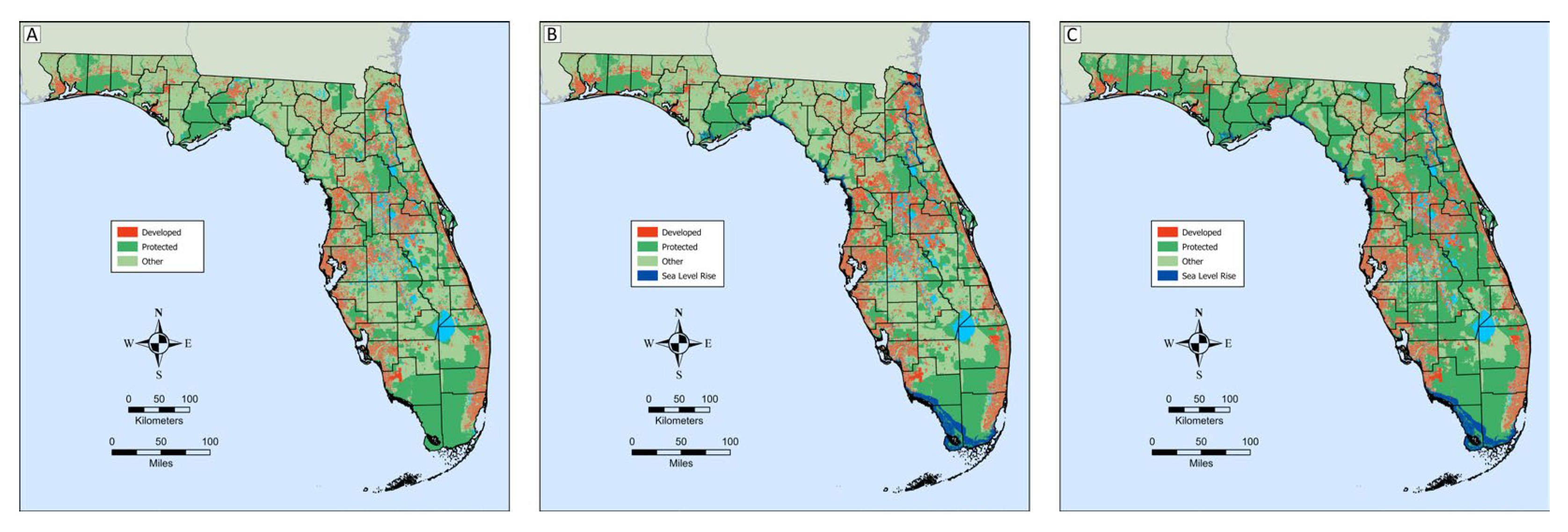
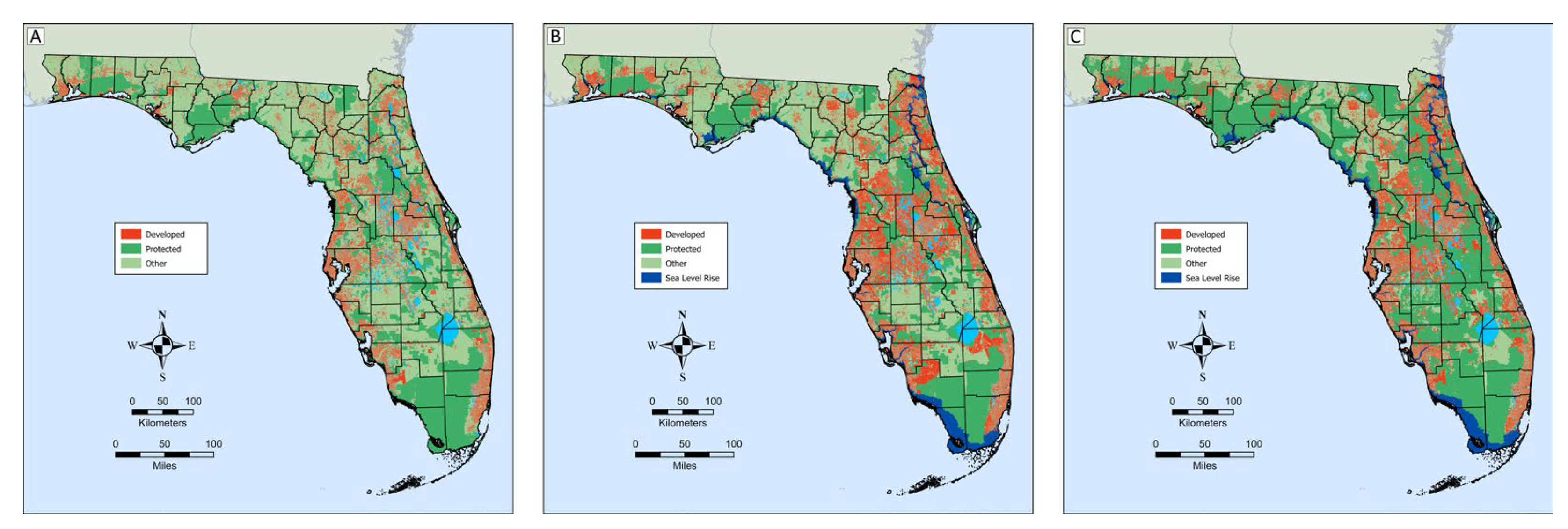
| Sprawl 2040 | Conservation 2040 | Sprawl 2070 | Conservation 2070 | |
|---|---|---|---|---|
| Development Densities | New population to be accommodated is allocated at each county’s 2019 gross density | New population is allocated at a development density 30% greater than that used for Sprawl 2040. | New population to be accommodated is allocated at each county’s 2010 gross urban density | The remaining new population to be allocated after the redevelopment population is removed is allocated at a development density 20% greater than that used for Sprawl 2070. |
| Redevelopment Areas | No new population is accommodated within existing urban areas | No new population is accommodated within existing urban areas | No new population is accommodated within existing urban areas | In all counties, some of the 2070 population growth is accommodated through an increase in the densities of existing urban areas |
| Protected lands | 2021 Florida Managed Areas are included as protected | In addition to 2021 Florida Managed Areas, 2021 Florida Forever project lands, and Florida Ecological Greenways Network Priorities 1–3 (the Florida Wildlife Corridor) are protected. | 2021 Florida Managed Areas are included as protected | In addition to 2021 Florida Managed Areas, 2021 Florida Forever project lands, and Florida Ecological Greenways Network Priorities 1–3 (the Florida Wildlife Corridor) are protected. |
| Agricultural lands | No agricultural lands are excluded from population allocation | All irrigated agricultural lands (using the 2045 projection) on good soils (USDA/NRCS Capability Rating Excellent – Marginal) from FSAID, 2020 are excluded from population allocation | No agricultural lands are excluded from population allocation | All irrigated agricultural lands (using the 2045 projection) on good soils (USDA/NRCS Capability Rating Excellent – Marginal) from FSAID, 2020 are excluded from population allocation |
| Sea Level Rise | 50% of population impacted by sea level rise is reallocated within the county affected. The other 50% are assumed to move out of the state. Areas between 0.25–0.75 m in elevation are assumed to be less likely to develop. | 50% of population impacted by sea level rise is reallocated within the county affected. The other 50% are assumed to move out of the state. Areas between 0.25–0.75 m in elevation are not allowed to develop. | 50% of population impacted by sea level rise is reallocated within the county affected. The other 50% are assumed to move out of the state. Areas between 0.9–1.4 m in elevation are assumed to be less likely to develop. | 50% of population impacted by sea level rise is reallocated within the county affected. The other 50% are assumed to move out of the state. Areas between 0.9–1.4 m in elevation are not allowed to develop. |
| Urban Suitability Criterion | Rational for Use | Weight |
|---|---|---|
| Proximity to Large Urban Areas (over 50,000 people) | Major urban areas tend to accommodate more additional population than do smaller urban areas. | 5% |
| Proximity to All Urban Areas (over 2500 people) | New urban development tends to occur in close proximity to existing urban development. | 27% |
| Proximity to coastline | The coast has historically been an attractor for urban development. However future sea level rise is expected to make these areas less attractive in 2070. | 9% |
| Preliminary Development Approvals | Areas within approved DRIs and DSAPs are highly likely to develop. The only DSAP that was used, however, was West Bay in Bay County, because the other existing DSAPs fell in the path and pattern of new urban development and their boundaries did not affect the pattern or timing of new urban development. | 8% |
| Road density | New urban development tends to occur in areas of relatively higher road density. | 12% |
| Presence/absence of wetlands | Urban development on lands without wetlands is often less costly than lands with wetlands. | 16% |
| Proximity to open water | Access to the view of water has historically been an attractor for development. | 2% |
| Proximity to major roads | Roads facilitate new urban development. | 5% |
| Absence of USDA/NRCS Soils within FSAID 2045 Projected Irrigated Agricultural Lands | There is an economic incentive to convert poorer agricultural soils to urban development before good agricultural soils. | 16% |
| CAMPS | GRAZING LAND SOIL CLASS 4 |
|---|---|
| IMPROVED AGRICULTURE | GRAZING LAND SOIL CLASS 5 |
| CROPLAND SOIL CLASS 1 | GRAZING LAND SOIL CLASS 6 |
| CROPLAND SOIL CLASS 2 | ORCHARD, GROVES, CITRUS |
| CROPLAND SOIL CLASS 3 | POULTRY, BEES, TROPICAL FISH, RABBITS, ETC |
| TIMBERLAND | DAIRIES, FEED LOTS |
| TIMBERLAND | ORNAMENTALS, MISC. AGRICULTURE |
| TIMBERLAND | MINING, PETROLEUM, AND GAS LANDS |
| TIMBERLAND | ACREAGE NOT ZONED AGRICULTURE |
| TIMBERLAND | VACANT RESIDENTIAL |
| TIMBERLAND | VACANT COMMERCIAL |
| GRAZING LAND SOIL CLASS 1 | VACANT INDUSTRIAL |
| GRAZING LAND SOIL CLASS 2 | VACANT INSTITUTIONAL |
| GRAZING LAND SOIL CLASS 3 |
| Value | Count | LUCIS_ID | SUITABILITY | DRI | COUNTY | ACRES | ALLYR | DORUC |
|---|---|---|---|---|---|---|---|---|
| 776092 | 1 | 27661 | 6.34 | 0 | ALACHUA | 0.22 | 0 | 53 |
| 776244 | 2 | 8001265 | 6.34 | 0 | PUTNAM | 0.44 | 2070 | 0 |
| 776457 | 10 | 27332 | 6.34 | 0 | ALACHUA | 2.22 | 0 | 61 |
| 776739 | 9 | 2078908 | 6.34 | 0 | DIXIE | 2.00 | 0 | 63 |
| 777217 | 5 | 8004729 | 6.34 | 0 | PUTNAM | 1.11 | 2070 | 99 |
| 778031 | 5 | 7929387 | 6.34 | 0 | PUTNAM | 1.11 | 2070 | 51 |
| 778117 | 2 | 2365932 | 6.34 | 0 | GILCHRIST | 0.44 | 0 | 60 |
| 778523 | 2 | 7939736 | 6.34 | 0 | PUTNAM | 0.44 | 2070 | 99 |
| 778736 | 3 | 2079670 | 6.34 | 0 | DIXIE | 0.67 | 0 | 56 |
| 778767 | 6 | 2075842 | 6.34 | 0 | DIXIE | 1.33 | 0 | 0 |
| 779113 | 10 | 2078874 | 6.34 | 0 | DIXIE | 2.22 | 0 | 56 |
| 779457 | 2 | 2076295 | 6.34 | 0 | DIXIE | 0.44 | 0 | 63 |
| 779470 | 12 | 2078875 | 6.34 | 0 | DIXIE | 2.67 | 0 | 56 |
| 779491 | 3 | 2370576 | 6.34 | 0 | GILCHRIST | 0.67 | 0 | 59 |
| 779592 | 4 | 7932144 | 6.34 | 0 | PUTNAM | 0.89 | 2070 | 99 |
| Baseline | % of Total Acreage | Sprawl 2040 | % of Total Acreage | Conservation 2040 | % of Total Acreage | |
|---|---|---|---|---|---|---|
| Developed | 5,428,000 | 14.94% | 6,374,000 | 17.54% | 6,102,000 | 16.79% |
| Protected Natural Land | 9,850,000 | 27.11% | 8,997,000 | 24.76% | 14,076,000 | 38.74% |
| Protected Agriculture | 856,000 | 2.36% | 854,000 | 2.35% | 3,236,000 | 8.91% |
| Agriculture | 6,418,000 | 17.66% | 6,022,000 | 16.57% | 3,751,000 | 10.32% |
| Other* | 11,778,000 | 32.41% | 11,028,000 | 30.35% | 6,110,000 | 16.81% |
| 2019 Open Water | 2,006,000 | 5.52% | 2,006,000 | 5.52% | 2,006,000 | 5.52% |
| Sea Level Inundation: Protected Lands | 0 | 0.00% | 854,000 | 2.35% | 928,000 | 2.55% |
| Sea Level Inundation: All Other Land Uses | 0 | 0.00% | 201,000 | 0.55% | 127,000 | 0.35% |
| Total Acreage | 36,337,000 | 100.00% | 36,337,000 | 100.00% | 36,337,000 | 100.00% |
| Total Land Acreage | 34,330,000 | 94.48% | 33,275,000 | 91.57% | 33,275,000 | 91.57% |
| Total Sea Level Inundation | 0 | 0.00% | 1,055,000 | 2.90% | 1,055,000 | 2.90% |
| Total Open Water including SLR | 2,006,000 | 5.52% | 3,062,000 | 8.43% | 3,062,000 | 8.43% |
| 2019 | % of Total Acreage | Sprawl 2070 | % of Total Acreage | Conservation 2070 | % of Total Acreage | |
|---|---|---|---|---|---|---|
| Developed | 5,428,000 | 14.94% | 8,881,000 | 24.44% | 7,612,000 | 20.95% |
| Protected Natural Land | 9,850,000 | 27.11% | 8,404,000 | 23.13% | 13,405,000 | 36.89% |
| Protected Agriculture | 856,000 | 2.36% | 852,000 | 2.34% | 3,115,000 | 8.57% |
| Agriculture | 6,418,000 | 17.66% | 4,645,000 | 12.78% | 2,931,000 | 8.07% |
| Other* | 11,779,000 | 32.42% | 9,867,000 | 27.15% | 5,586,000 | 15.37% |
| 2019 Open Water | 2,006,000 | 5.52% | 2,006,000 | 5.52% | 2,006,000 | 5.52% |
| Sea Level Inundation: Protected Lands | 0 | 0.00% | 1,296,000 | 3.57% | 1,432,000 | 3.94% |
| Sea Level Inundation: All Other Land Uses | 0 | 0.00% | 386,000 | 1.06% | 250,000 | 0.69% |
| Total Acreage | 36,337,000 | 100.00% | 36,337,000 | 100.00% | 36,337,000 | 100.00% |
| Total Land Acreage | 34,330,000 | 94.48% | 32,648,000 | 89.85% | 32,648,000 | 89.85% |
| Total Sea Level Inundation | 0 | 0.00% | 1,682,000 | 4.63% | 1,682,000 | 4.63% |
| Total Open Water including SLR | 2,006,000 | 5.52% | 3,772,000 | 10.38% | 3,772,000 | 10.38% |
| Sprawl 2040 Acres Lost to SLR | % of Total Acreage | Conservation 2040 Acres Lost to SLR | % of Total Acreage | |
|---|---|---|---|---|
| Developed Land | 31,000 | 0.08% | 31,000 | 0.08% |
| Protected Natural Lands | 852,000 | 2.34% | 915,000 | 2.52% |
| Protected Agricultural Lands | 2000 | 0.01% | 3000 | 0.01% |
| Unprotected Agriculture | 3000 | 0.01% | 3000 | 0.01% |
| All Other Land Uses | 167,000 | 0.53% | 103,000 | 0.35% |
| Total Sea Level Inundation | 1,055,000 | 2.97% | 1,055,000 | 2.97% |
| Sprawl 2070 Acres Lost to SLR | % of Total Acreage | Conservation 2070 Acres Lost to SLR | % of Total Acreage | |
|---|---|---|---|---|
| Developed Land | 94,000 | 0.26% | 94,000 | 0.26% |
| Protected Natural Lands | 1,291,000 | 3.55% | 1,403,000 | 3.86% |
| Protected Agricultural Lands | 4000 | 0.01% | 4000 | 0.01% |
| Unprotected Agriculture | 10,000 | 0.03% | 10,000 | 0.03% |
| All Other Land Uses | 283,000 | 0.78% | 171,000 | 0.47% |
| Total Sea Level Inundation | 1,682,000 | 4.63% | 1,682,000 | 4.63% |
Disclaimer/Publisher’s Note: The statements, opinions and data contained in all publications are solely those of the individual author(s) and contributor(s) and not of MDPI and/or the editor(s). MDPI and/or the editor(s) disclaim responsibility for any injury to people or property resulting from any ideas, methods, instructions or products referred to in the content. |
© 2025 by the authors. Licensee MDPI, Basel, Switzerland. This article is an open access article distributed under the terms and conditions of the Creative Commons Attribution (CC BY) license (https://creativecommons.org/licenses/by/4.0/).
Share and Cite
Farrah, D.; Volk, M.; Hoctor, T.S.; Young, V.; Carr, M.; Zwick, P.D.; Goodison, C.; O’Brien, M. A Model for Future Development Scenario Planning to Address Population Change and Sea Level Rise. Land 2025, 14, 1536. https://doi.org/10.3390/land14081536
Farrah D, Volk M, Hoctor TS, Young V, Carr M, Zwick PD, Goodison C, O’Brien M. A Model for Future Development Scenario Planning to Address Population Change and Sea Level Rise. Land. 2025; 14(8):1536. https://doi.org/10.3390/land14081536
Chicago/Turabian StyleFarrah, Daniel, Michael Volk, Thomas S. Hoctor, Vivian Young, Margaret Carr, Paul D. Zwick, Crystal Goodison, and Michael O’Brien. 2025. "A Model for Future Development Scenario Planning to Address Population Change and Sea Level Rise" Land 14, no. 8: 1536. https://doi.org/10.3390/land14081536
APA StyleFarrah, D., Volk, M., Hoctor, T. S., Young, V., Carr, M., Zwick, P. D., Goodison, C., & O’Brien, M. (2025). A Model for Future Development Scenario Planning to Address Population Change and Sea Level Rise. Land, 14(8), 1536. https://doi.org/10.3390/land14081536






